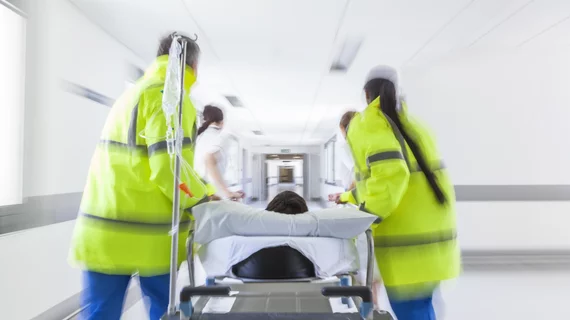Heart attacks after TAVR: New AMI data ‘reassuring’ at first glance, but questions remain
Subsequent acute myocardial infarctions (AMIs) after transcatheter aortic valve replacement (TAVR) procedures are “infrequent,” according to a new analysis published in JACC: Cardiovascular Interventions.[1] In addition, researchers noted, the use of percutaneous coronary intervention (PCI) and coronary artery bypass grafting (CABG) after AMI events was similar among patients with and without a prior TAVR.
“Coronary artery disease (CAD) is common in patients undergoing TAVR, with a changing prevalence according to the evolving risk profile of TAVR recipients,” wrote senior author Harold L. Dauerman, MD, an interventional cardiologist with the University of Vermont Medical Center, and colleagues. “As TAVR has extended to younger, lower risk patients with long residual life expectancy, there is increased possibility of future acute coronary events.”
Hoping to gain a better understanding of how TAVR may impact a patient’s long-term cardiovascular health, Dauerman et al. tracked data from more than 200,000 patients who underwent the popular procedure from January 2016 to December 2022. All patient data came from the Vizient Clinical Data Base, an administrative resource that houses claims from more than 1,000 U.S. facilities. In-hospital mortality after a ST-segment elevation myocardial infarction (STEMI) or non–ST-segment elevation myocardial infarction (NSTEMI) was the group’s primary patient outcome, though they also explored several secondary outcomes.
Overall, AMI events were “infrequent” after TAVR. The STEMI rate among TAVR patients was 25 events per 100,000 person-years, and the NSTEMI rate among TAVR patients was 229 events per 100,00 person-years. In-hospital mortality was more likely among STEMI patients with prior TAVR (27.1% vs. 16.7%), but less likely among NSTEMI patients with a prior TAVR (5.8% vs. 8.2%).
“Our study confirms that STEMI after TAVR is associated with poor outcomes,” the authors wrote, adding that “left ventricular changes associated with aortic stenosis” and PCI complications may have contributed to that trend.
The group also used propensity score matching to compare 144 STEMI patients with a history of TAVR with 144 STEMI patients with no history of TAVR. The same technique was used to compare 1,321 NSTEMI patients with a history of TAVR with 1,321 NSTEMI patients with no history of TAVR. These data revealed that the use of coronary revascularization (PCI or CABG) was similar among patients with a prior TAVR procedure. Coronary revascularization was needed to treat 65.3% of STEMI patients with a history of TAVR and 63.9% of STEMI patients with no such history. Among NSTEMI patients, meanwhile, the coronary revascularization rates were 41.4% among patients with a history of TAVR and 41.7% among patients with no such history.
“Future studies should focus on elucidating the factors explaining the high mortality rates in post-TAVR patients with STEMI and identify targets for improving outcomes,” the authors concluded.
Click here for the team’s full analysis.
Editorial offers perspective on life after TAVR
A corresponding editorial, also published in JACC: Cardiovascular Interventions, evaluated the study’s findings at length. The authors described this new study as “a welcome addition to the literature” while sharing a certain amount of caution.
“On the surface, these findings appear reassuring in light of ongoing concerns that the presence of the TAVR valve could interfere with future coronary access—particularly in the setting of primary PCI for STEMI,” wrote David Cohen, MD, MSc, an interventional cardiologist with St. Francis Hospital and Heart Center and Cardiovascular Research Foundation, and co-author Wally Omar, MD, an interventional cardiologist with Northwell Health. “However, as the authors acknowledge, the study has important limitations that should be considered when interpreting their findings.”
One of those limitations is that the Vizient database “only captures readmissions when they occur at the same hospital where the patient received their index TAVR.” This suggests post-TAVR AMI rates are likely underestimated.
“It is also possible that deaths that occurred at another hospital or out of hospital entirely would be underreported by a hospital-centric database, thus leading to overestimation of the time each patient is alive which could lead to further underestimation of the true incidence of MI,” they added.
Cohen et al. noted that patients returning to the same hospital where they underwent TAVR are more likely to receive treatment from interventional cardiologists with experience “engaging coronary arteries around and through transcatheter valves.” This could mean the study’s revascularization rates represent a “best-case scenario” of sorts as opposed to data that can be generalized to all U.S. hospitals.
“It is important to note that these limitations are not unique to the current study, but rather are shared to some extent by virtually all real-world evidence and post-market surveillance studies in the United States,” the authors wrote.
The two cardiologists concluded their editorial by praising the “important new information” included in the analysis by Dauerman et al.
“First, even after considering potential missing events, it is comforting that the rates of AMI are relatively low after TAVR and resemble those seen in the general population,” they wrote. “It is also reassuring that among post-TAVR patients who present with either STEMI or NSTEMI, rates of invasive coronary angiography and PCI are comparable to those seen in matched patients without TAVR. Nonetheless, further study using other data sources will be necessary to determine whether this finding is limited to TAVR centers or whether similar rates can be achieved in the general community.”
Click here to read the full editorial.

